|

by Indur M. Goklany
August
30, 2022
from
CO2Coalition Website
|
Indur Goklany is a
Member of the CO2 Coalition.
He
is an author, researcher, and longtime civil servant.
He
became involved with the Intergovernmental Panel on
Climate Change since before its inception.
His
degrees are PhD and MS (Electrical Engineering and
Systems Science) and
Bachelor of Technology (Electrical Engineering).
|
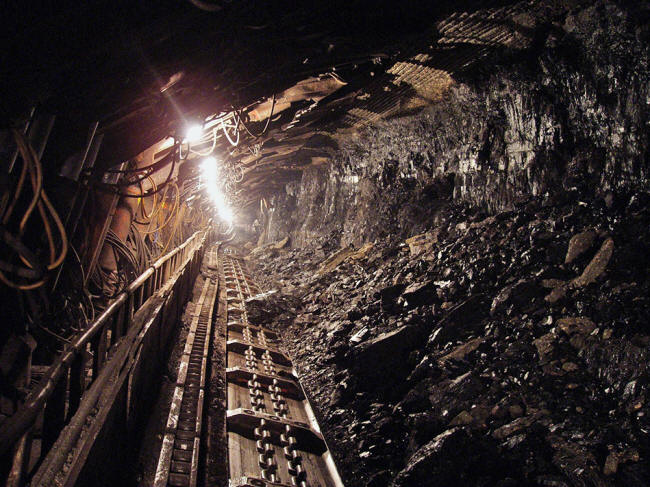
Contrary to the claims of
proponents of the
Green New Deal and Net Zero, fossil fuels are the
greenest fuels.
First, uniquely among energy sources, fossil fuel use
emits CO2,
which is the ultimate source of the elemental building block,
carbon, found in all carbon-based life, i.e., virtually all life on
Earth.
The increased amplitude of the seasonal cycle in atmospheric CO2 and
satellite-borne instrumentation to measure solar-induced chlorophyll
fluorescence from plants provide direct evidence that global
photosynthetic activity (or Gross Primary Production, GPP, a measure
of the change in global biomass) has increased over the past several
decades (Frankenberg et al. 2011; Graven et al. 2013).
Observed
variations (Campbell et al. 2017) of atmospheric CO2 over the past
two centuries are consistent with increasing primary productivity...
Other satellite studies also show that the earth has been greening
continually in recent decades (Zhu et al. 2016; Piao et al. 2020).
Second, fossil fuel dependent technologies have increased
agricultural yields directly or indirectly by at least 167% (Goklany
2021).
This increase in agricultural productivity is due to the use
of fossil-fuel-dependent technologies, specifically,
nitrogen
fertilizers, pesticides and carbon dioxide fertilization resulting
from fossil fuel emissions.
This has enabled human beings to meet
their demands for food using less cropland, which then spares land
for the rest of nature.
Thus, in the absence of fossil fuels, at
least 167% more land would have to be cultivated to maintain global
food production at current levels.
That would be equivalent to
increasing current cropland from 12.2% of global land area (GLA) (FAO
2019) to 32.7%.
But diversion of habitat (land) to agriculture is
already deemed to be the greatest threat to global biodiversity.
Fossil fuels have, therefore, not only increased productivity of
already-converted habitat, they have forestalled conversion of at
least an additional 20.4% of GLA.
Consequently, the world sustains 10 times more people today (7.97
billion) than at the start of the Industrial Revolution (786 million
in 1750), while supporting more biomass.
Moreover, to compare the impacts of the various energy options on
habitat, we should consider the physical footprint needed to produce
an equivalent amount of energy via each option (solar, wind and the
various fossil fuels).
Second, for wind and solar to be viable
substitutes for fossil fuel energy, they should be coupled with
batteries to solve their intermittency problem which requires
substantial amounts of metals and other materials that must be
mined, smelted and refined which necessarily would disturb the land.
The Greening of the Earth and the Increase in Biomass
Based on satellite data, Zhu et al. (2016) found that from
1982-2009, 25-50% of global vegetated area had become greener while
4% had become browner.
They attributed,
-
70% of the greening to CO2
fertilization from emissions from fossil fuel combustion (which
increases photosynthesis and water use efficiency, WUE, of most
vegetation)
-
9% to nitrogen deposition (also from the use of
fossil-fuel-derived fertilizers)
-
8% to climate change
-
4% to
land use change
The first three, responsible cumulatively for 87%
of the greening,
are related to
the use of fossil fuels...
Chen et al. (2019) report that global leaf area increased by 5.4
million km2 over 2000-2017, equivalent to the area of the Amazon
rainforest (Piao et al. 2020).
They noted, per MODIS data, that 34%
of the globe is greening while 5% is browning.
Leaf area increased
at the rate of 2.3% per decade from 2000‒2017.
China and India
accounted for 25% and 6.8% of the global net increase in leaf area
despite only having 6.6% and 2.7% of global vegetated area,
respectively.
Greening occurred mainly in forests and croplands in
China, and croplands (82%) in India, suggesting that greening is
from reforestation and agricultural practices (e.g., fertilizers and
multi-cropping).
Song et al. (2018) found that, contrary to prevailing wisdom,
global
tree cover increased by 2.24 million km2 (+7.1%) from 1982-2016. A
net loss in the tropics was outgained by increases in the extra-tropics.
Global bare ground cover decreased by 1.16 million km2
(-3.1%), most notably in agricultural regions in Asia.
60% of all
land use/cover changes were associated with direct human activities
and 40% with indirect factors such as climate change, which
indicates net reforestation and net de-desertification over the
study period, partly attributed to climate change.
Reforestation was
probably enabled by increased productivity of agricultural lands
substantially due to the use of fossil-fuel-derived fertilizers and
pesticides, and increases in CO2 fertilization (indirectly from
using fossil fuels).
Together, they rendered land surplus to
agricultural needs.
Using data from 1982-2011, Gao et al. (2019: 9) found that
productivity, using annual maximum Normalized Difference Vegetation
Index (NDVI) as a proxy, increased significantly in 45.8% of global
grasslands while declining significantly in 1.5%.
Using data from 1982-2011, Cheng et al. (2017) found that global
gross primary productivity (GPP) increased, mainly due to increased
WUE of vegetation, an expected, but underemphasized, consequence of
increasing CO2 concentrations.
Despite large-scale occurrence of
droughts and disturbances over the study period, annual GPP
increased 0.6 ▒ 0.2% per year.
About 65% of vegetated land showed
significant positive trends in GPP.
Ecosystem WUE also increased
significantly in 78% of vegetated areas.
In a review article on global greening drawing upon the above
studies, among others, Piao et al. (2020) note that:
"Greening is pronounced over intensively farmed or afforested areas,
such as in China and India, reflecting human activities.
However,
strong greening also occurs in biomes with low human footprint, such
as the Arctic, where global change drivers play a dominant role.
Vegetation models suggest that CO2
fertilization is the main driver of greening on the global
scale, with other factors being notable at the regional scale."
Satellite-derived empirical trends in greening from 1982 to 2018,
using the mean growing season (GS) leaf area index (LAI) as a
surrogate, are shown in Figure 1 (Piao et al. 2020).
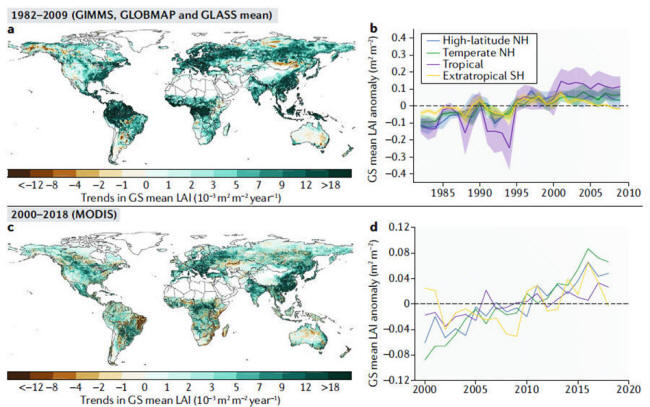
Figure 1.
Changes in mean growing season (GS)
leaf area index (LAI)
based on empirical satellite-derived data.
(a) Based on changes in
Advanced Very-High-Resolution Radiometer (AVHRR)
LAI from
1982-2009.
The AVHRR LAI dataset is the average of
three sets of
satellite data products
(GIMMS13, GLOBMAP23 and GL ASS192).
(b)
Based on changes over four regions from 1982-2009.
(c) Based on
changes in
Moderate Resolution Imaging Spectroradiometer (MODIS)
LAI
from 2000-2018.
(d) Based on changes in MODIS LAI
over four regions
during 2000-2018.
Source: Piao et al.2020.
Finally, Sun et al. (2020) estimated that GPP increased at the rate
of 0.16% per year from 2000 to 2014 largely due to CO2
fertilization.
Combining this estimate with Campbell at al.'s
estimate of a 31% increase in GPP during the 20th century, gives a
cumulative increase of 34% from 1900 to 2014.
The increased productivity from higher photosynthetic rates and WUE
due to higher CO2 concentrations implies the biosphere produces more
plant matter, i.e.,
more food for all carbon-based organisms even
under water-stressed conditions,
...which further enables earth to
sustain higher biomass, that is, more organisms and/or a larger
variety of species while also increasing its resiliency to drought,
a chronic condition detrimental to most life forms (but which may
favor drought-tolerant species).
Habitat Saved by Fossil Fuel Usage from Conversion to Human Use
Use of fossil fuel technologies has enabled human beings to spare
20.4% of GLA for the rest of nature.
This exceeds both the habitat
lost currently to cropland (12.2% of GLA) and the global cumulative
area currently reserved or identified as conservation areas
(estimated at 14.6% of GLA) (Goklany 2021).
Clearly, conversion of
this magnitude of habitat to agriculture would devastate global
biodiversity.
The increased agricultural productivity allowed cropland in many
areas to revert to forest or other non-agricultural use.
For
example,
between 1990 and 2020 forestland in the USA and Western
Europe increased 2.4% and 10.1% despite population increases of 30%
and 11%, respectively (FAOSTAT 2022).
Physical Footprint of Various Electrical Generating Facilities
Different energy sources have different demands on land.
Figure 2
compares the physical footprint needed to site a 1 MW power plant
using different energy sources.
The estimates shown include direct
and indirect land requirements based on U.S. practices as of 2015.
They include estimates of land used during resource production, for
transport and transmission lines, and store waste materials.
Both
one-time and continuous land-use requirements were considered
(Stevens et al. 2017).
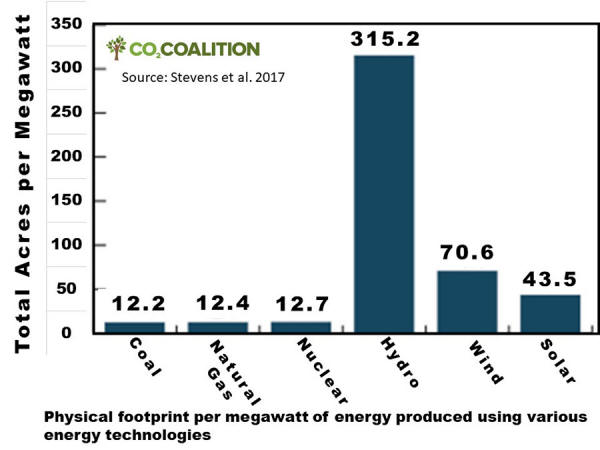
Figure 2.
Physical footprint
per megawatt of energy produced
using
various energy technologies,
based on practices as of 2015.
(Source:
Stevens et al. 2017)
Figure 2 shows that compared to fossil fuels, solar would need more
than three times as much land; wind, five times as much; and
hydropower, 25 times as much.
Land Needed for
"Clean" and Fossil Fuel Energy Systems
To replace fossil fuel and nuclear generation, wind and solar would
need to be coupled, at a minimum, with battery backup to provide
electricity round-the-clock.
However, the manufacture of batteries,
as well as solar panels and wind turbines involves relatively vast
quantities of metals and minerals.
This necessarily entails equally
vast mining operations and land disturbance.
Although, the amount of mining would no doubt increase, the
estimated global areal extent of mining operations is very small
relative to agricultural operations (5.7 million hectares vs. almost
5 billion hectares, about one-third of which is cropland and the
remainder, pastureland and meadow for livestock - Maus 2020, FAO
2019).
Thus, the additional amount of surface disturbance may be
relatively minor.
This is because while agriculture depends
substantially on the energy harvested from the sun which is a
function of the surface area occupied by the array of
solar panels
or
windmills, mining involves the excavation and processing
(including transportation, smelting, and refining) of vast
quantities of material (volume operations).
Nevertheless, these
operations themselves require substantial energy consumption and
emit significant amounts of air and water pollution.
The International Energy Agency (2022) notes that,
solar and wind
powered energy systems typically require more metals and minerals
than their fossil fueled analogs...
For instance, it notes that a
typical electric vehicle requires six times the mineral inputs of a
conventional car and an onshore wind plant requires nine times more
mineral resources than a natural gas-fired power plant, while
offshore wind plants require fifteen times as much as natural gas.
Figure 3 shows the demand estimated by the International Energy
Agency for various metals to generate 1 MW of power using different
energy technologies (IEA 2022).
It shows that demand for these
metals is substantially larger for renewable energy technologies.
However, this figure excludes demand for concrete and cement, steel
and aluminum.
The demand for those materials is shown in Figure 4
(in tonnes per TWh of electricity generated).
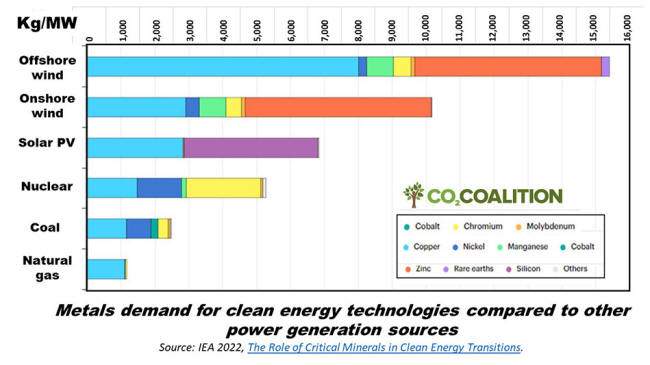
Figure 3.
Metals demand for clean energy technologies
compared to
other power generation sources.
Note: Steel and aluminum are not
included.
The values for offshore wind and onshore wind are based
on
the direct-drive permanent magnet synchronous
generator system
(including array cables)
and the doubly-fed induction generator
system respectively.
The values for coal and natural gas are based
on ultra-supercritical plants and combined-cycle gas turbines.
Actual consumption can vary by project
depending on technology
choice, project size and installation environment.
Note: Lithium
demand is included in the "rare earths" category.
Source: IEA 2022,
The Role of Critical Minerals in Clean Energy Transitions.
We see from Figure 3 that fossil fuels (natural gas and coal, in
that order) have substantially lower demand for metals (and,
therefore, associated land disruption), followed by,
nuclear, solar
and, finally, wind... [Metals demand for hydropower was not provided
in the IEA report.]
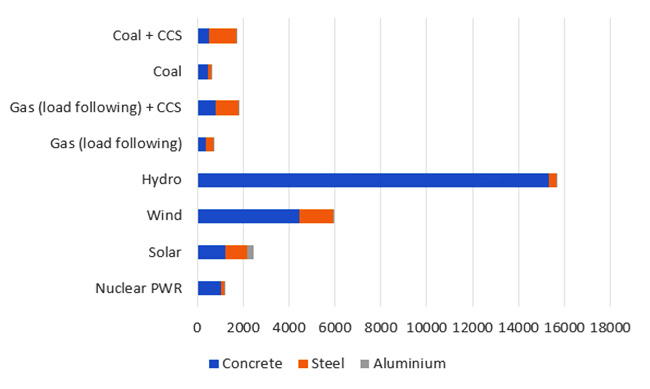
Figure 4.
Demand for
concrete, steel and aluminum (in tonnes per TWh)
for different energy technologies.
Source:
World Nuclear Association
2022.
Note: Carbon Capture and Storage (CCS)
in combination with
coal and gas
are included although CCS
is not generally economically
viable.
Figure 4 shows that fossil fuels and nuclear have the lowest total
demand for concrete, steel and aluminum, followed by solar, wind and
hydroelectric (in that order).
Once again, we see that land
disturbance would be substantially greater for renewables than for
fossil fuel and nuclear.
Figure 4 also includes demand for concrete, aluminum and steel for
plants that may use carbon capture and storage (CCS) in combination
with coal and gas although CCS has not been proven to be
economically viable even in special circumstances where the CCS
product can be used in captive facilities, e.g., for enhanced oil
recovery.
Notably,
the advantage of coal and gas over nuclear
(regarding demand for these three materials) disappears if CCS is
employed.
However, it should also be noted that economic viability
does not seem to constrain policymakers nowadays.
Conclusion
Fossil fuel combustion has increased the amount of carbon dioxide
available to green the earth...
This has contributed the major share
of the approximately 34% increase in the earth's GPP that has
occurred since 1900 that has literally greened the earth.
Second, by
enhancing agricultural productivity, fossil fuel-dependent
technologies have forestalled the conversion of at least 20.4% of
global land area to agricultural uses.
This is 25% larger than the
entire area of North America.
Remarkably, this exceeds the total
amount of land currently set aside globally for both cropland
(12.2%) and conservation worldwide (14.6%).
Third, relative to
renewable energy sources, fossil fuels have smaller physical
footprints and lower demand for metals and other minerals.
The
latter substantially limits mining and other land disturbance.
Such
disturbance would inevitably result in "browning" of the land.
Hence, fossil fuels are indeed the greenest energy sources.
But "greenest" does
not necessarily mean the "cleanest".
That
distinction may have to be reserved for
nuclear energy, but that is
another topic.
Acknowledgments
My thanks to Drs. Will Happer and
Greg Wrightstone for their
incisive and constructive comments, which have resulted in a
much-improved paper.
Any flaws and omissions, however, are my
responsibility.
References
Campbell JE, Berry JA, Seibt U, Smith SJ, Montzka SA, Launois T,
Belviso S, Bopp L, Laine M. Large historical growth in global
terrestrial gross primary production. Nature. 2017
Apr;544(7648):84-7.
Chen, C. et al. China and India lead in greening of the world
through land- use management. Nat. Sustain. 2, 122-129 (2019a).
Cheng, Lei, Lu Zhang, Ying-Ping Wang, Josep G. Canadell, Francis HS
Chiew, Jason Beringer, Longhui Li, Diego G. Miralles, Shilong Piao,
and Yongqiang Zhang. 2017. Recent increases in terrestrial carbon
uptake at little cost to the water cycle. Nature Communications,
8(1): 110.
Forkel M, Carvalhais N, R÷denbeck C, Keeling R, Heimann M, Thonicke
K, Zaehle S, Reichstein M. Enhanced seasonal CO2 exchange caused by
amplified plant productivity in northern ecosystems. Science. 2016
Feb 12;351(6274):696-9.
Frankenberg C, Fisher JB, Worden J, Badgley G, Saatchi SS, Lee JE,
Toon GC, Butz A, Jung M, Kuze A, Yokota T. New global observations
of the terrestrial carbon cycle from GOSAT: Patterns of plant
fluorescence with gross primary productivity. Geophysical Research
Letters. 2011 Sep;38(17).
Gao, Qingzhu, Mark Schwartz, Wenquan Zhu, Yunfan Wan, Xiaobo Qin,
Xin Ma, Shuo Liu, Matthew Williamson, Casey Peters, and Yue Li.
2016. Changes in global grassland productivity during 1982 to 2011
attributable to climatic factors. Remote Sensing, 8(5): 384.
Goklany IM. Reduction in global habitat loss from
fossil‐fuel‐dependent increases in cropland productivity.
Conservation Biology. 2021 Jun;35(3):766-74.
Graven HD, Keeling RF, Piper SC, Patra PK, Stephens BB, Wofsy SC,
Welp LR, Sweeney C, Tans PP, Kelley JJ, Daube BC. Enhanced seasonal
exchange of CO2 by northern ecosystems since 1960. Science. 2013 Sep
6;341(6150):1085-9.
International Energy Agency 2022. The Role of Critical World Energy
Outlook Special Report Minerals in Clean Energy Transitions.
Maus V, Giljum S, Gutschlhofer J, da Silva DM, Probst M, Gass SL,
Luckeneder S, Lieber M, McCallum I. A global-scale data set of
mining areas. Scientific data. 2020 Sep 8;7(1):1-3.
Piao S, Wang X, Park T, Chen C, Lian XU, He Y, Bjerke JW, Chen A,
Ciais P, T°mmervik H, Nemani RR. Characteristics, drivers and
feedbacks of global greening. Nature Reviews Earth & Environment.
2020 Jan;1(1):14-27.
Song, Xiao-Peng, Matthew C. Hansen, Stephen V. Stehman, Peter V.
Potapov, Alexandra Tyukavina, Eric F. Vermote, and John R.
Townshend. 2018. Global land change from 1982 to 2016. Nature,
560(7720): 639.
Stevens, Landon et al. 2017. The Footprint of Energy: Land Use Of
U.S. Electricity Production. Strata. Available at
https://docs.wind-watch.org/US-footprints-Strata-2017.pdf.
Zhu, Zaichun, Shilong Piao, Ranga B. Myneni, Mengtian Huang,
Zhenzhong Zeng, Josep G. Canadell, Philippe Ciais et al. 2016.
Greening of the Earth and its drivers. Nature climate change 6(8):
791.
Gregory Wrightstone is a geologist; executive director of the CO2
Coalition, Arlington, Va.; and author of "Inconvenient Facts - The Science
that Al Gore doesn't want You to Know."
|






